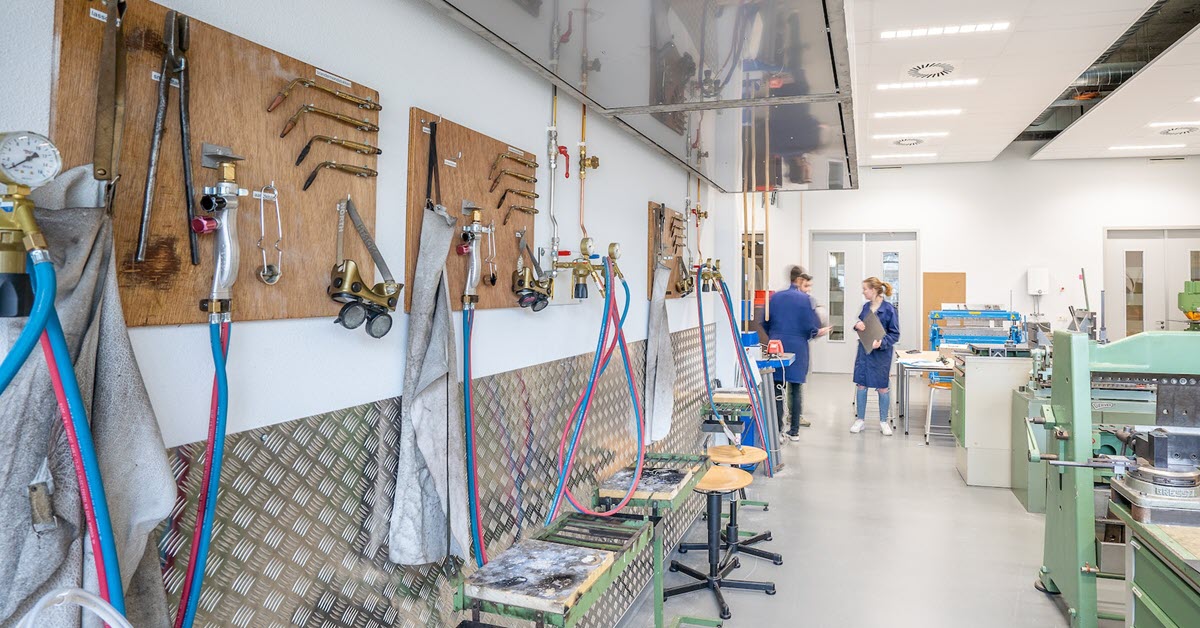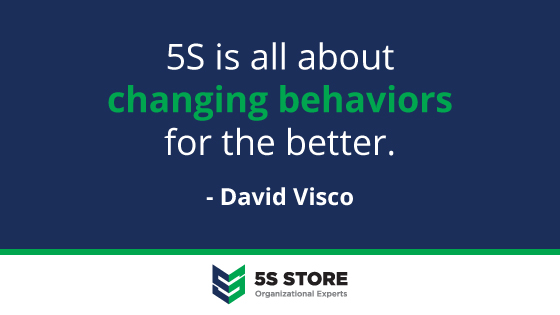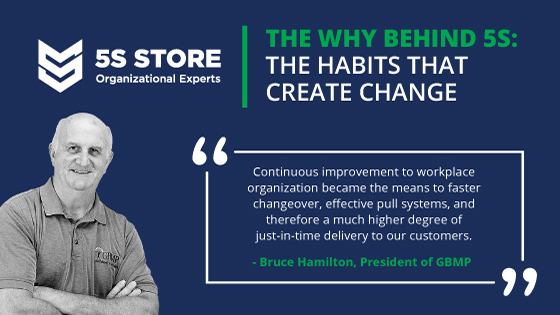
The Why Behind 5S: The Habits that Create Change

This is a guest article contributed by Bruce Hamilton, president of the Greater Boston Manufacturing Partnership.
Shigeo Shingo had a profound impact on my career direction, first as an operating manager and later as a consultant. Shingo encouraged that every means of improvement be understood in context of the goals it was meant to achieve.
“First know-why,” he said, “then know how.”
Organizations have a bad habit of glamming onto a particular best practice, thinking of it as an end in itself. “Don’t confuse means and ends,” he said. Understand why you are employing a particular Lean tool. As such, in 1986 my factory began our Lean journey with a goal of having the right parts at the right time.
What my work history taught me about why 5S matters…
The means we chose were pull production and set-up reduction, both good countermeasures for us. At the time, we were the kings and queens of overproduction – always busy building something, but rarely the right thing for the customers’ needs at the time.
Through pull production, which Mr. Shingo referred to as “authorized” by the customer (as opposed to “speculative”, i.e., built to a forecast), we made some rapid early improvement in customer service. We built smaller batches of components needed for actual customer orders. This freed up machining capacity, shortening lead-times, and improving customer deliveries.
It worked – for a while.
After several months of high service levels, we faced a new reality of part shortages. We “hit the rocks.” That term means just what it sounds like, describing what happens to production flow when the deep river of inventory that covers the problems is depleted.
We’d used up most of our excess inventory, and unless we could drastically reduce machine changeover time, our small batch strategy would not work. So, set-up reduction became the means to a goal of smaller batches. It was at this point, we discovered the critical need for a stable and standardized workplace: 5S.

How 5S stabilized and standardized my factory’s journey…
For the first three years of our lean journey, we’d been unaware of the concept of workplace organization… And it showed. During a site visit by the Shingo Prize in 1989, the Lead Examiner, George Koenigsaecker, commented on the lack of clarity in the workplace:
“You’ve done a nice job with pull systems and even some early changeover attempts, but your folks are having to do this in spite of a cluttered floor, excess equipment, crowded aisles and missing tools.”
A week after the site visit, UPS delivered to me a four-foot cylindrical tube. In it was a very large poster with each of five S’s, expressed in Japanese, but with English translations. Also enclosed was a short note of encouragement and suggestion that “your site will benefit from 5S.”
This was our major take-away from the Shingo site visit:
To produce products just-in-time for the customers required authorized production (triggered by Kanban), which in turn required fast changeover of equipment.
And fast changeover of equipment depended on a stable environment in which everything needed for changeover was immediately available. This gave a special meaning to 5S: Continuous improvement to workplace organization became the means to faster changeover, effective pull systems, and therefore a much higher degree of just-in-time delivery to our customers.
When I visit companies today, I often see that 5S is the first Lean tool that they have deployed, but that sometimes they are not clear about the purpose. I relate my own 5S story and then ask them why 5S is important to them.

Do you know why it’s important to you?
About Bruce Hamilton
Bruce Hamilton is the President of GBMP.
Bruce is also Director Emeritus for the Shingo Institute, home of the Shingo Prize, and is a Senior Examiner for the Shingo Prize and a Certified Shingo Institute workshops Facilitator. He is a past recipient of the Shingo Prize in both the business and academic categories and an Inductee to the Shingo Academy (with five awards in all). In 2015 he was inducted into the AME Manufacturing Hall of Fame.
Bruce is a sought after speaker concerning management’s role in Lean transformation, noted for his hands-on experience, humor, and insight. His clients have included Raytheon, Beth Israel Deaconess Hospital, OC Tanner, New Balance as well as many smaller organizations.
He is the creator of Toast Kaizen, as well as numerous other award-winning Lean training DVDs including Single Patient Flow and, most recently, Improvement Kata. Bruce is co-author of e2 Continuous Improvement System, a comprehensive learn-by-doing guide for Lean transformation. He publishes a Blog, “OldLeanDude”, about understanding the Toyota Production System and gaining its full benefits. He also and hosts a free monthly webinar called “Tea Time with The Toast Dude”.
Before joining GBMP, Bruce held management positions in Marketing, IT, Operations Management, and General Management. In 1990 led his organization to a Shingo Prize. He is equally at home in administrative, operational and healthcare environments, with over 30 years as a student of Lean. As an early adopter of Lean, his factory was visited by Shigeo Shingo, Shigihiro Nakamura and Ryuji Fukuda. From 1994-1998, he was coached by Hajime Ohba and TSSC.
Bruce holds a B.A. and has attended Bowdoin College and University of Arizona.

